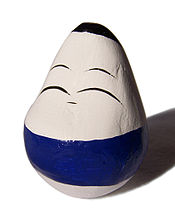- Okiagari-koboshi
-
 Okiagari-koboshi from Aizuwakamatsu, Fukushima
Okiagari-koboshi from Aizuwakamatsu, Fukushima
Okiagari-koboshi or Okiagari-kobōshi (起き上がり小法師, getting-up little priest) is a Japanese traditional doll. The toy is made from papier-mâché and is designed so that its weight causes it to return to an upright position if it is knocked over.[1] Okiagari-koboshi is considered a good-luck charm and a symbol of perseverance and resilience.[2]
Contents
History
The makers of the earliest okiagari-koboshi likely modeled them after a Chinese toy called Budaoweng (不倒翁; not-falling-down old man) that is similarly weighted. Okiagari-koboshi has long been popular among Japanese children. It is mentioned in a 14th-century play called Manju-Kui,[3] and folklorist Lafcadio Hearn recorded a lullaby from Matsue in Izumo Province in the early 20th century that lists the doll as a gift for a young child:
Nenneko, nenneko nenneko ya!
Kono ko nashite naku-yara?
O-chichi ga taranuka? — o-mama ga taranuka?
Ima ni ototsan no ōtoto no o-kaeri ni
Ame ya, o-kwashi ya, hii-hii ya,
Gara-gara, nagureba fuito tatsu
Okiagarikoboshi! —
Neneko, neneko, nenneko ya!Translated, it says:
Sleep, sleep, sleep, little one!
Why does the child continue to cry?
Is the milk deficient? — is the rice deficient?
Presently when father returns from the great Lord's palace,
Ame will be given to you, and also cake, and a hii-hii likewise,
And a rattle as well, and an okiagarikoboshi
That will stand up immediately after being thrown down.[4]Okiagari-koboshi are popular in the Aizu region of Fukushima Prefecture. There, the dolls are sold in red and blue varieties.[5] People buy the dolls during the Tokaichi (Tenth-day Market) held each 10 January.[6] Shoppers typically throw several okiagari-koboshi down at the same time; those that stand back up are supposedly the lucky ones. Tradition mandates the purchase of one okiagari-koboshi for each member of the family plus one extra in the hope that the family will grow over the coming year.[5]
Daruma dolls
 Daruma doll of the okiagari-koboshi type
Daruma doll of the okiagari-koboshi type
One kind of Daruma doll works on the same principle as okiagari-koboshi and is sometimes referred to by that name; whenever it is thrown down, it rights itself.[7] This depiction of the Buddhist monk Bodhidharma likely arose in connection with a legend that says that he once meditated for nine years, which caused his legs to either atrophy or fall off.[8] A 17th-century children's song shows that the okiagari-koboshi Daruma dolls of the time were almost identical to their modern equivalents:
Hi ni! fu ni!
Fundan Daruma ga
Akai zukin kaburi sunmaita!Once! twice!
Ever the red-hooded Daruma
Heedlessly sits up again![9]Notes
References
- Hearn, Lafcadio (1901). A Japanese Miscellany. Boston, Massachusetts: Little, Brown, and Company.
- Lee, Sherwood. "Historical asset: Kitakata". Japan National Tourist Organization. Accessed 20 January 2007.
- McFarland, H. Neill (1986). "Feminine Motifs in Bodhidharma Symbology in Japan". Asian Folklore Studies, Vol. 45, No. 2.
- "Tokaichi (Tenth Day Market)". Aizu Wakamatsu City. Accessed 20 January 2007.
See also
- Roly-poly toy
Wikimedia Foundation. 2010.
